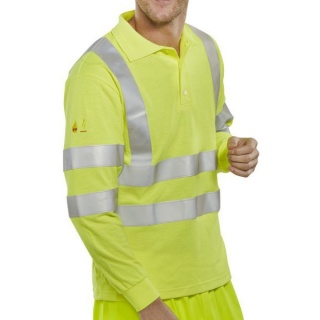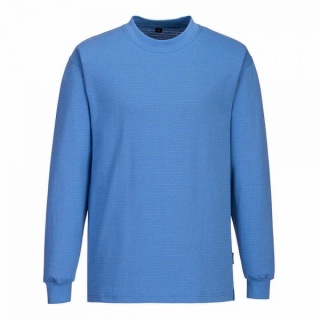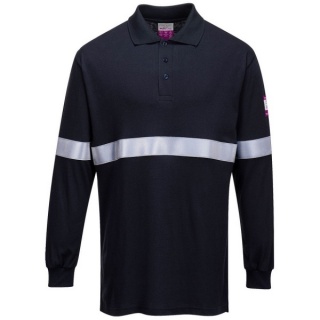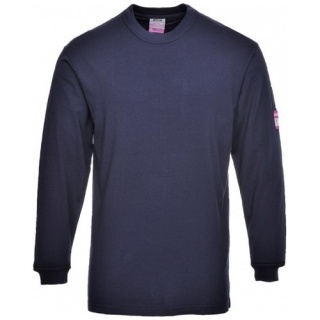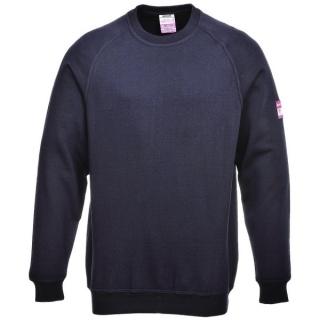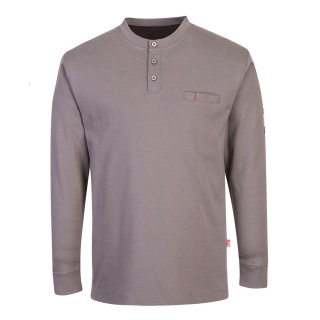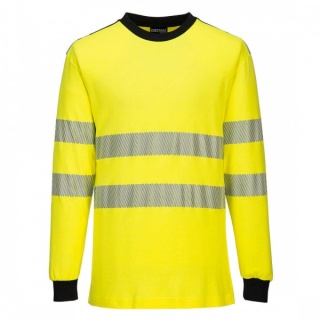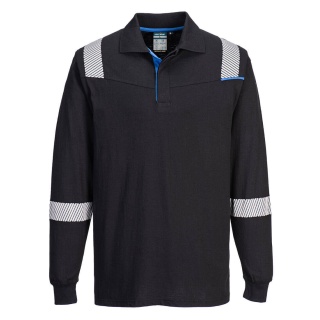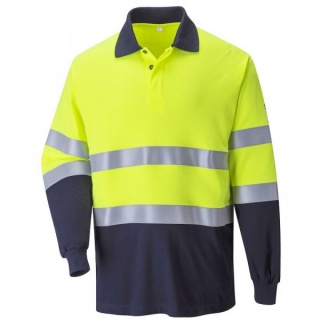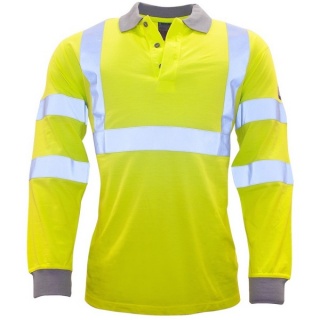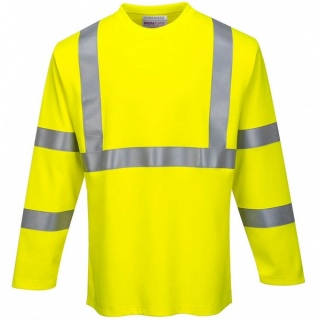 Portwest Anti-Static Modaflame Flame Resistant Knit Range
Portwest Anti-Static Modaflame Flame Resistant Knit Range
The Portwest FR10 Modaflame Knit shirt is the ultimate choice for protection against heat and flame. With its inherent flame resistant qualities and high cotton content, this shirt provides both safety and comfort. The button placket opening, ribbed cuffs, and ribbed collar add to its comfortable fit, and the 40+ UPF rating ensures that you are protected from 98% of harmful UV rays. The CE-CAT III and CE certification guarantees that the shirt meets meets the health and safety requirements set by the European Union, and the durable shell fabric, made from 60% Modacrylic, 39% cotton, and 1% carbon fibre in a 2 layer 200g construction, is built to last. Whether you're working in a high-risk environment or just want added protection, the Portwest Modaflame Knit shirt has you covered.
The Portwest FR10 is convenient for cooler weather, and ideal for workers in industries exposed to heat. The stylish design of the garment has a 3-button placket, finished with a ribbed collar and cuffs.
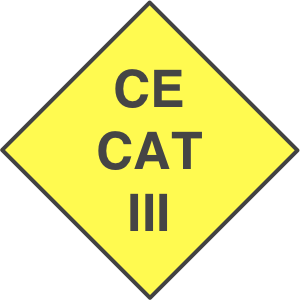



Features
- Inherent flame resistant qualities will not diminish with washing
- Protection against radiant, convective and contact heat
- High cotton content for superior comfort
- Button placket opening
- Ribbed cuffs for added comfort
- Ribbed collar
- 40+ UPF rated fabric to block 98% of UV rays
- Outstanding colour fastness and shrinkage results
- CE-CAT III
- CE certified
Shell Fabric
 Modaflame Knit: 60% Modacrylic, 39% Cotton, 1% Carbon Fibre x 2 layer 200g
Modaflame Knit: 60% Modacrylic, 39% Cotton, 1% Carbon Fibre x 2 layer 200g
Modaflame
Constructed from an inherently fire resistant yarn of 60% modacrylic, 39% cotton and 1% carbon fibre. Tested to exceed the required EN Standards, the Modaflame Knit range is strong, durable and highly inoovation. This fabric has the ability to withstand heat and flame and protect against the danger caused by static electricity and flame. These inherent flame resistant properties will not diminish with repeated washing.
Product Technical Information
Standards
- EN ISO 11612 A1, B1, C1, F1
- EN 1149 -5
- IEC 61482-2 IEC 61482-1-1 Elim 4.4 CAL/CM²
- IEC 61482-2 IEC 61482-1-2 APC 1
- ASTM F1959/F1959M-12 EBT = 4.3 CAL/CM2 (HAF = 66%)
Washcare
Documentation
EN ISO 11612: 2008 - Protective Clothing Against Heat and Flame
The Performance requirements set out in this international standard are applicable to garment, which could be worn for a wide range of end uses, where the is a need for clothing with limited flame spread properties and where the used can be exposed to radiant, convective or contact heat or molton metal splashes.
This test uses standard methods and conditions to predict the performance of fabric/garment in the event of contact with heat or flames. Garment features such as seams, closures and logos must be tested as well as the fabric. Tests must be carried out on pre=treated components according to the manufacturers care label.
Specific Testing is listed below:
- Dimensional Charge
- Limited Flame Spread (A1+A2)*
- Convective Heat (B) – 3 Levels
- Radiant Heat (C) - 4 Levels
- Molten Aluminium Splash (D) – 3 Levels
- Molten Iron Splash E - 3 Levels
- Contact Heat (F) – 3 Levels (Temp 250 Degrees Celcius)
- Heat Resistance at a temperature of 180 Degrees Celcius
- Tensile Strength Must meet a minimum of 300N
- Tear Strength must meet a minimum of 15N
- Bursting Strength
- Seam Strength
Garment Design requires that coverage must be provided from the neck to the wrist and to the ankles.
Optional Testing includes water vapour resistance and manikin testing for overall burn prediction.
*This test must be carried out on fabric and seams.
EN1149 - 5 - Protective Clothing against the Thermal Hazards of an Electric Arc
This European Standard is part of a series of standards for test methods and requirements for electrostatic properties of protective clothing. The standard specifies material and design requirements for garments used as part of a total earthed system, to avoid incendiary discharges. The requirements may not be sufficient in oxygen enriched flammable atmospheres. This standard is not applicable for protection against mains voltages.
EN 1149 consists of the following parts:
EN 1149-1: Test Method for measurement of surface resistivty.
EN 1149-2: Test Method for measurement of the electrical resistance through a material (Vertical resistance)
EN 1149-3: Test Methods for measurement of charge decay.
EN 1149-4: Garment Test (under development)
EN 1149-5: Material Performance and design requirements.
Electrostatics dissipative protective clothing shall be able to permanently cover all non-complying materials during normal use. Conductives parts (Zips, Buttons etc) are permitted provided they are cover by the outermost material when in use.
IEC 61482-2: 2009 - Protective Clothing Against The Thermal Hazards of An Electric Arc
This standard specifies requirements and test methods applicable to materials and garments for protective clothing against the thermal effects of an electric arc event. An electric arc is a continuous electric discharge of high current between conductors generating very bright light and intensive heat.
Two international test methods have been developed to provide information on the resistance of clothing to the thermal effects of electric arcs. Each method gives different information. To comply with our standard either or both tests must be carried out.
Box Method EN 61482-1-2
The fabric/garment is exposed to an electric arc confined in a specific box with a specific electrode arrangement for 0.5 seconds. Class 1 is to the current of 4kA arc, Class 2 is to a current 7 kA arc. Test conditions for Class 1 and 2 try to stimulate typical exposure conditions for a short circuit current of 4kA and 7kA respectively.
Open Arc Method EN61482-1-1
This test method aims to establish the ATPV (Arc Thermal Performance Value) of Ebt (Energy Breakopen Threshold) of a fabric. The APTV is the amount of energy required to cause a 2nd degree burn through the material prior to breakopen (50% probability). The EBT is the amount of energy where the material breaks-open (50% probability). This is normally the upper thermal limit of the fabric where the fibres are damaged and material loses mechanical strength, Both APTV and Ebt are expressed in calories per cm2.
ASTM F1959/F1959M-14e1 - Standard Test Method for Determining the Arc Rating of Materials for Clothing
Significance and Use
5.1 This test method is intended for the determination of the arc rating of a material, or a combination of materials.
5.1.1 Because of the variability of the arc exposure, different heat transmission values may be observed at individual sensors. Evaluate the results of each sensor in accordance with Section 12.
5.2 This test method maintains the specimen in a static, vertical position and does not involve movement except that resulting from the exposure.
5.3 This test method specifies a standard set of exposure conditions. Different exposure conditions may produce different results. In addition to the standard set of exposure conditions, other conditions representative of the expected hazard may be used and shall be documented in the reporting of the testing results.
Scope
1.1 This test method is used to measure the arc rating of materials intended for use as flame resistant clothing for workers exposed to electric arcs that would generate heat flux rates from 84 to 25 120 kW/m2 [2 to 600 cal/cm2s].
1.2 This test method will measure the arc rating of materials which meet the following requirements: less than 150 mm [6 in.] char length and less than 2 s afterflame when tested in accordance with Test Method D6413.
1.2.1 It is not the intent of this test method to evaluate non flame-resistant materials except where used as under layers in multiple-layer specimens.
1.3 The materials used in this test method are in the form of flat specimens.
1.4 This test method shall be used to measure and describe the properties of materials, products, or assemblies in response to convective and radiant energy generated by an electric arc under controlled laboratory conditions.
1.5 The values stated in SI units shall be regarded as standard except as noted. Within the text, alternate units are shown in brackets. The values stated in each system may not be exact equivalents therefore alternate systems must be used independently of the other. Combining values from the systems described in the text may result in nonconformance with the method.
1.6 This test method does not apply to electrical contact or electrical shock hazards.
1.7 This standard shall not be used to describe or appraise the fire hazard or fire risk of materials, products, or assemblies under actual fire conditions. However, results of this test may be used as elements of a fire assessment which takes into account all of the factors which are pertinent to an assessment of the fire hazard of a particular end use.
1.8 This standard does not purport to address all of the safety concerns, if any, associated with its use. It is the responsibility of the user of this standard to establish appropriate safety and health practices and determine the applicability of regulatory requirements prior to use. For specific precautions, see Section 7.
